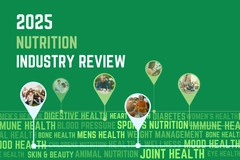
- Industry news
Industry news
- Category news
- Reports
- Key trends
- Multimedia
Multimedia
- Journal
- Events
- Suppliers
Suppliers
- Home
- Industry news
Industry news
- Category news
- Reports
- Key trends
- Multimedia
Multimedia
- Events
- Suppliers
Suppliers
Nutrition trending: How social media is pushing the nutrition agenda

08 Mar 2018 --- As a means to stay in touch with friends, old and new, or to stay abreast of the latest developments in the world, social media is opening up new opportunities for people to interact with the (virtual) world around them. Popular platforms such Instagram, Snapchat and Facebook are taking up an increasingly pervasive place in the average consumer's life. NutritionInsight looks at how social media is influencing consumers when it comes to nutrition, and how the industry can benefit.
According to a 2017 Innova Market Insights consumer study, novelty and variety are key drivers in the purchasing behavior of one in ten European (Germany, UK, France, Italy and Spain) and North American (US and Canada) consumers. Social media is a key component of this. One in ten consumers from Mexico, US, Canada, Spain, Netherlands and Australia are influenced by social media in their food and beverage purchases. In China and India, that number rises to one in five.
“Instagrammable” food is becoming increasingly vital to Millennials, so the time for visually appealing foods has arrived, notes Lu Ann Williams, Director of Innovation at Innova Market Insights. “People do fantastic Pinterest pages, for example, all color-coded or highlighting really interesting things like this.”
But when it comes to food and beverages, social media’s reach stretches beyond sharing attractive pictures of well curated meals.
 “Nutrition and healthy lifestyle influencers love to build a community and one way that they do this is by encouraging their followers to join them in various health or fitness challenges,” says Erin Quinn, Manager Media & Social at Foodmix Marketing Communications.
“Nutrition and healthy lifestyle influencers love to build a community and one way that they do this is by encouraging their followers to join them in various health or fitness challenges,” says Erin Quinn, Manager Media & Social at Foodmix Marketing Communications.
“More than ever, diet trends have a reach that expands further than before. It used to be that a diet guru wrote a book, did a publicity tour and maybe friends and family would share the book/information,” says Jenna A. Bell, PhD, RD, Senior Vice President of Pollock Communications and Director of Food & Wellness.
“Now, you can access recommendations and information about diet trends from ‘friends’ through social channels. And it gives people the opportunity to promote their own diet plan and share their success stories. It has taken the art of testimonials to another level with frequent photos, journal-type posts, recipes and meal plans.”
So, how can the food and beverage industry best benefit from social media?
Social media offers an unprecedented amount of interaction with consumers, both Bell and Quinn note. Applications such as Instagram are a great platform for reaching potential health-conscious fans, especially if a brand is able to capitalize on trending diets and ingredients.
“A quick search on Instagram shows just how popular diet hashtags are on the platform: #Whole30 (>3.4 million), #Paleo (>11.9 million), #Vegan (>55 million), and #Protein (>19 million) all have significant usage. If you have a brand that's relevant to these and other trending diet and health hashtags, it's definitely something to keep in mind when developing content,” Quinn notes.
“At Foodmix Marketing and Communications, we often work with chefs to develop recipes for our clients to use on their websites, sales materials, social media, etc., and we have sometimes specifically asked the chefs for recipes that we believe will be ‘social media friendly,’ like one-pot meals or Whole30 because we know that people will be searching for these types of recipes,” Quinn adds.
But using the right hashtags isn't enough alone, you also need strong content (visually appealing, informative, etc.), Quinn adds.
Influencers
Another frequently seen strategy of using social media to appeal to certain audiences revolves around partnering with established health and nutrition influencers, such as athletes or popular bloggers, and creating on-trend content, Quinn notes.
“If you are marketing, say a protein bar, your influencer team might include people like a nutritionist, a marathoner, a Pilates instructor and a busy mom who can each speak to how the protein bar fits into their active lifestyles,” Quinn notes.
“We recently worked with an influencer who does a Whole30 challenge every January and ties that into her content for the month. Our client, a coffee and tea company, was located in this influencer's hometown and we had worked with her previously, so it was a natural fit to partner with her to communicate our client's healthy lifestyle messaging to an audience that was looking for that type of content,” Quinn adds.

A great example of a success story amid this new social media era is Halo Top Ice Cream. In the five years since the introduction of the low calorie ice cream in the US, Halo Top Creamery has spent almost nothing on advertising. Instead the company has relied on a social media strategy that has attracted over one million followers.
An important part of that strategy is Instagram, where the company had 557,000 followers as of the end of August 2017, up from 325,000 in March. Halo Top’s Instagram account features image after image of its carton pints swimming in melted swirls of vibrant oranges, purples and browns.
“On a daily basis, brands have access to their own focus group. They can answer questions, respond to feedback and create relationships that fuel brand loyalty. On the flipside, their critics have a voice and platform as well. Thus, the industry needs to be prepared to respond to negativity in a way that won’t cause more harm than good,” notes Bell.
This is where social media shows its potential to become a double-edged sword: while these platforms can rapidly spread opinions and news – be it positive or negative – about certain ingredients, products or diets, they are also a razor-sharp tool for companies to directly communicate with consumers.
In fact, according to Sproutsocial, an impressive 71 percent of US businesses use Instagram, while 81 percent of Instagram users “follow” a business on the social media platform.
 Drawbacks?
Drawbacks?
Although social media platforms can function as a convenient way for businesses to establish direct contact with consumers, it is important that those consumers, in turn, do their due diligence with the health/nutrition advice they read online, Quinn notes.
“Is this person a registered dietitian/nutritionist or just someone with a pretty Instagram account who happened to read a book on healthy eating? Not to say that there's anything wrong with the latter, as they can offer the point of view of a ‘regular’ person trying to live a healthy lifestyle and some of the associated challenges with that, but it is important for consumers to be aware of an influencer's qualifications so that they can make informed decisions,” she says.
Back in 2014, Janet Helm, MS, RD, Chief Food and Nutritionist, Weber Shandwick, wrote an article for WebMD on how social media could be a tremendous help to achieve a healthier lifestyle.
However, with the increased popularity of popular platforms, Helm notes the link between nutrition and social media has become more complicated.
“Now I feel like it’s harder to sort through the hype and the misinformation,” notes Helm, who is also a blogger at Nutrition Unplugged and co-founder of Nutrition Blog Network and Healthy Aperture. “There’s been a new crop of ‘healthy eating gurus’ that take the approach of ‘eat like me, look like me.’ They don’t have any nutrition credentials, but they encourage their readers to simply do what they do – which isn’t always good advice.”
Still, it is not all negative, Helm notes, as social media trends also push forward healthy eating patterns.
“One of the most positive trends in social media is the plant-forward movement. Food and nutrition bloggers are inspiring the public with craveable, innovative recipes that make vegetables, whole grains, legumes and nuts as the center of plate star,” she notes.
With consumers becoming more mindful about their lifestyle choices and finding new avenues to learn about food and diets via the Internet, social media is sure to function as a vital tool for businesses and industry to inform and educate consumers on all things new in the world of nutrition.
by Lucy Gunn











